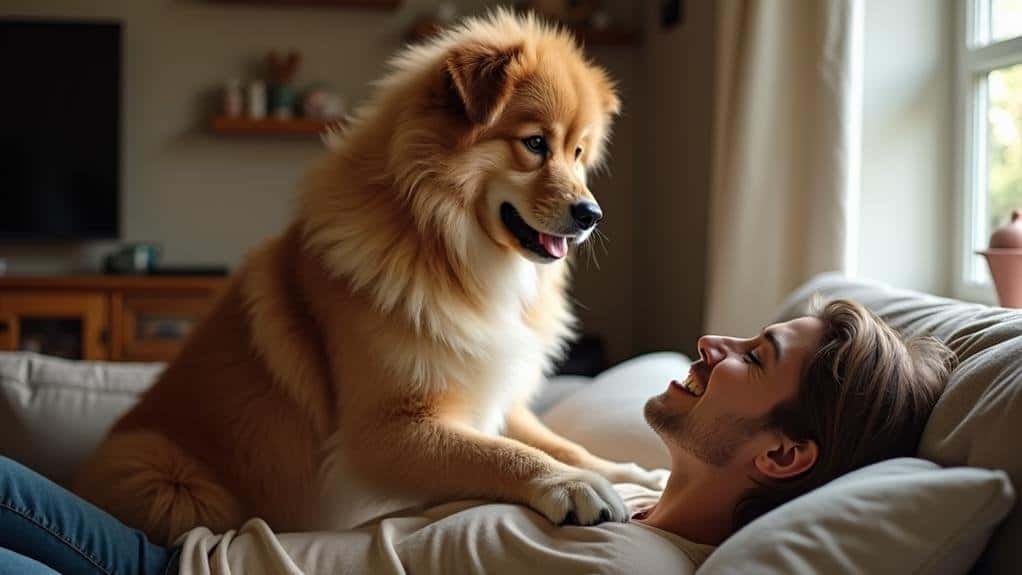Your dog stands on you for several reasons. It's often a sign of affection, showing trust and a desire for closeness. However, it can also be attention-seeking behavior, especially if you've inadvertently rewarded it in the past. Sometimes, anxiety or stress drives this action, as physical contact provides comfort and security. In multi-dog households, standing might assert dominance or mark territory. Understanding your dog's body language and the context of the behavior is essential. By observing patterns and considering factors like your dog's overall demeanor, you'll gain deeper insights into this intriguing canine conduct.
Decoding Canine Standing Behavior
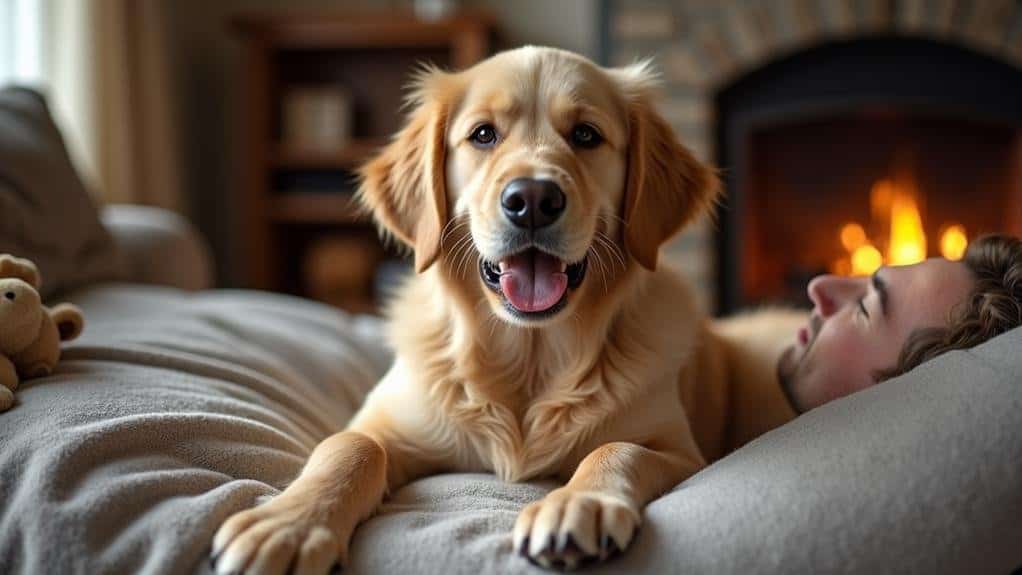
When it comes to decoding canine standing behavior, it's vital to recognize that your dog's actions speak volumes. Dogs often stand on their owners as a display of affection, seeking closeness and strengthening their emotional bond. This behavior is deeply rooted in their instinctual need for security and comfort.
However, standing can also be a sign of dominance or territory marking, especially in multi-dog households. Your furry friend might be asserting their position in the pack hierarchy. It's important to observe their body language, such as tail wagging or a stiff posture, to accurately interpret their intentions.
Sometimes, dogs engage in this behavior as an attention-seeking tactic. If you've inadvertently rewarded this action with treats or affection in the past, your dog may have learned that standing on you yields positive reinforcement.
Additionally, anxiety or stress can trigger this behavior. During unfamiliar situations or loud noises, your dog might seek reassurance by standing on you.
Affection or Attention-Seeking?
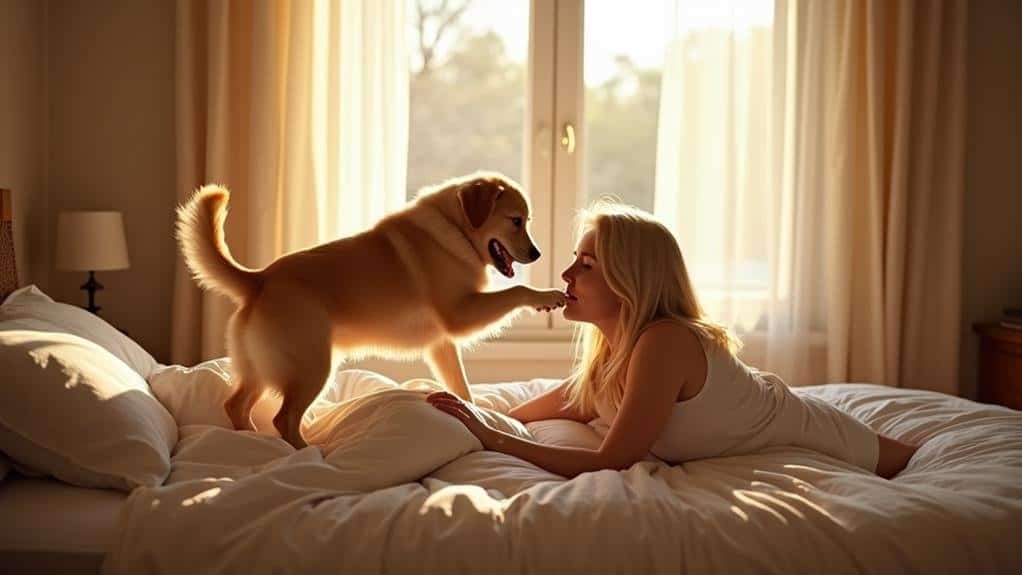
Understanding your dog's standing behavior is just the first step. To determine whether it's affection or attention-seeking, you'll need to reflect on the context and your dog's overall demeanor.
Dogs often stand on their owners as a form of affection, seeking comfort and physical closeness. This behavior signifies trust and emotional bonding between you and your canine companion.
However, attention-seeking behavior can also manifest in this way. By standing on you, your dog makes it difficult for you to ignore them, often resulting in increased interaction. Over time, this behavior may be reinforced if you inadvertently reward your dog with attention, treats, or petting when they stand close.
To better understand your dog's motivations, ponder these emotional cues:
- Does your dog seem relaxed and content when standing on you?
- Are they exhibiting other signs of affection, like tail wagging or gentle nuzzling?
- Do they persistently seek your attention through this behavior?
- Does the standing occur more frequently when you're engaged in other activities?
Anxiety and Security Concerns

Your dog's standing behavior can often be rooted in anxiety and security concerns. When your furry friend climbs onto you during stressful situations, they're seeking comfort and reassurance. This is especially common in dogs with separation anxiety, who use physical closeness to feel safe and connected to their owners.
Standing on you serves multiple purposes for anxious dogs. It allows them to maintain a higher vantage point, giving them a sense of control over their environment during unfamiliar or loud events. This elevated position can help alleviate their anxiety by providing a better view of potential threats.
Research shows that this close contact with you can actually reduce your dog's cortisol levels, demonstrating the calming effect of proximity during times of stress.
If you notice your dog repeatedly engaging in this standing behavior, it may signal a need for emotional support and intervention from you.
As a dog owner, recognizing this behavior as a sign of anxiety can help you address your pet's security concerns more effectively. By understanding the reasons behind this affectionate yet anxious behavior, you can provide the reassurance and comfort your dog needs during stressful times.
Dominance and Pack Dynamics
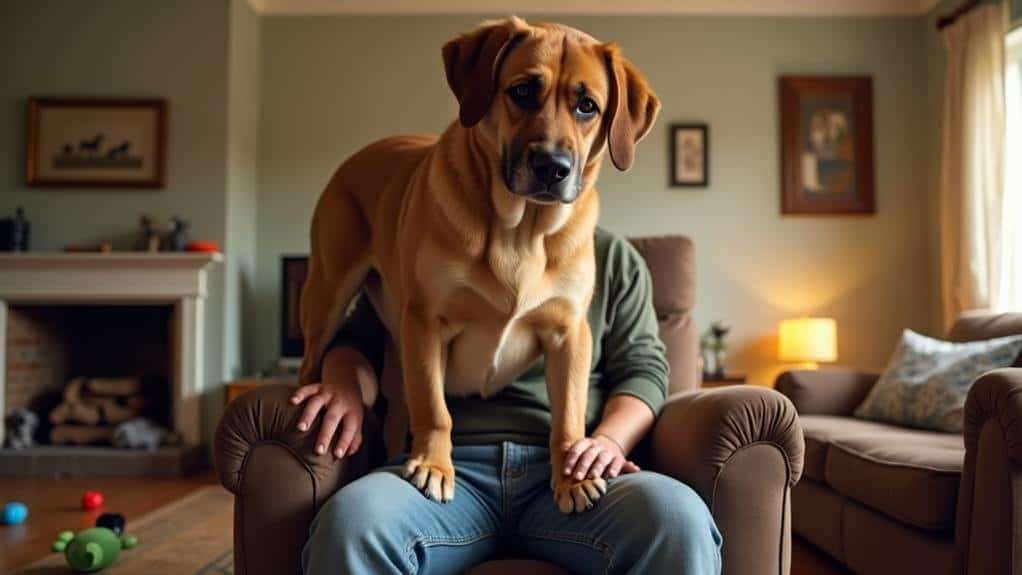
While anxiety can drive your dog's standing behavior, dominance and pack dynamics also play a significant role.
Dogs may stand on you to assert dominance, especially in multi-dog households where establishing social hierarchy is vital for their behavioral dynamics. This action signifies their desire to claim space or leadership over you, whom they may perceive as a lower-ranking pack member.
Unneutered male dogs, with higher testosterone levels, are more likely to exhibit dominance behaviors, including standing on their owners.
To manage these behaviors and maintain a balanced relationship, it's important to understand pack dynamics and establish clear boundaries. Consistent training reinforces your role as the pack leader, helping to prevent dominance-related issues from escalating.
To address your dog's dominance-driven standing behavior:
- Firmly establish yourself as the pack leader
- Implement consistent training routines
- Set clear boundaries and enforce them
- Consider neutering if your male dog exhibits excessive dominance
Managing Your Dog's Actions
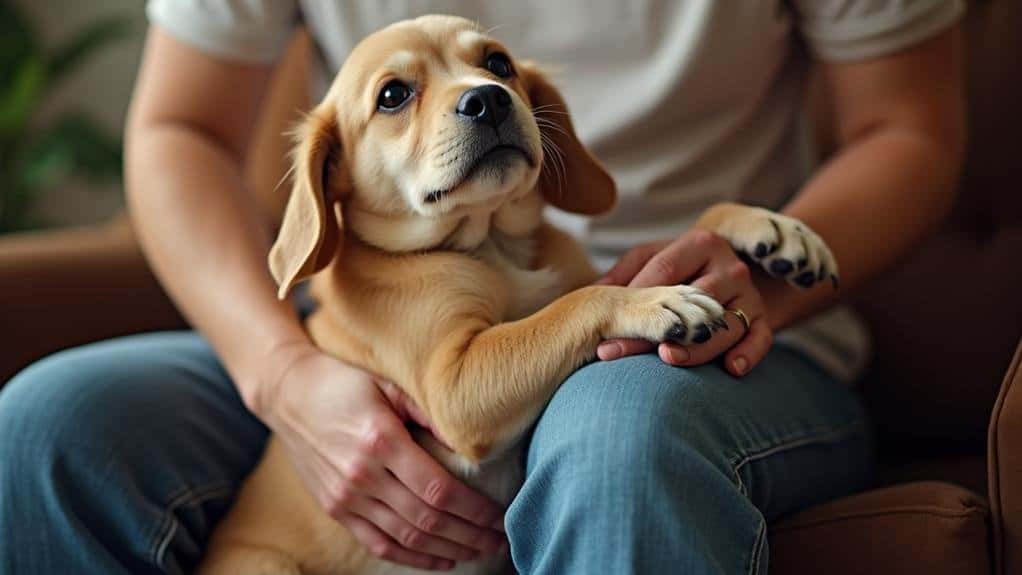
Effective management of your dog's standing behavior requires a blend of consistency, patience, and positive reinforcement. To help redirect this behavior, provide a comfortable dog bed or designated space where your furry friend can feel secure without standing on you.
Implement positive training techniques by rewarding your dog when they engage in desired behaviors, establishing clear communication and reducing their reliance on standing for attention.
Consistency is key in managing your dog's actions. Set clear boundaries and maintain them, ensuring your pet understands when standing is acceptable and when it's not.
Pay attention to your dog's body language to anticipate their needs and offer appropriate alternatives for affection.
Interactive toys can be valuable tools in diverting your dog's attention from standing behavior. Encourage independent play, which can help reduce their need for constant physical closeness.
If you're struggling to manage persistent standing issues, don't hesitate to consult a professional trainer. They can provide tailored strategies to effectively address and modify this behavior, ensuring a harmonious relationship between you and your canine companion.
Frequently Asked Questions
What Does It Mean When Your Dog Stands on You?
When your dog stands on you, it's often a sign of affection and bonding. They're seeking closeness, attention, or asserting dominance. It can also indicate anxiety, a need for security, or a way to communicate specific needs.
Why Is My Dog so Affectionate Towards Me?
Your dog's affection stems from their deep bond with you. They're seeking comfort, security, and emotional closeness. It's a natural instinct reinforced by positive interactions. Your dog trusts you and wants to strengthen your connection through physical closeness.
How Do You Know When Your Dog Is Protecting You?
You'll know your dog's protecting you when they stand close, create a barrier, and show alertness. Look for a stiff posture, growling, and direct eye contact with strangers. They may bark or vocalize as a warning signal.
Why Does My Dog Like to Stand on My Chest?
Your dog stands on your chest to seek closeness and comfort. It's a sign of trust and affection. They're looking for warmth, security, and attention. Sometimes, it's playful or a way to assert dominance in your relationship.
Conclusion
You've now gained insight into why your dog stands on you. Whether it's seeking affection, attention, or security, or asserting dominance, understanding your pup's motivations is key. Remember, each dog is unique, so observe your furry friend's behavior closely. If this habit becomes problematic, don't hesitate to redirect it gently. With patience and consistent training, you'll foster a balanced relationship that meets both your needs and your dog's.

